The city trying to make urban living good for your health
 Getty Images
Getty ImagesGlasgow is notorious for the same ills that plague city dwellers everywhere. Is urban life itself harmful to humans – or can we rethink cities so that they can help us to thrive?
If you live in Glasgow, you are more likely to die young. Men there die a full seven years earlier than their counterparts in other UK cities. Until recently, the causes of this excess mortality remained a mystery.
The phenomenon has become known as the Glasgow Effect. But David Walsh, a public health programme manager at the Glasgow Centre for Population Health, who led a study on the excess deaths in 2010, wasn’t satisfied with how the term was being used. “It turned into a Scooby-Doo mystery but it’s not an exciting thing. It’s about people dying young, it’s about grief.”
He wanted to work out why Glaswegians have a 30% higher risk of dying prematurely – that is before the age of 65 – than those living in similar post-industrial British cities. In 2016 his team published a report looking at 40 hypotheses – from vitamin D deficiency to obesity and sectarianism. “The most important reason is high levels of poverty, full stop,” says Walsh. “There’s one in three children who are classed as living in poverty at the moment.”
But even with deprivation accounted for, mortality rates in Glasgow remained inexplicable. Deaths in each income group are about 15% higher than in Manchester or Liverpool. In particular, deaths from “diseases of despair” – drug overdoses, suicides and alcohol-related deaths – are high. In the mid-2000s, after adjusting for sex, age and deprivation, there was almost a 70% higher mortality rate for suicide in Glasgow than in the two English cities.
Walsh’s report revealed that radical urban planning decisions from the 1950s onwards had made the physical and mental health of Glasgow’s population more vulnerable to the consequences of deindustrialisation and poverty.
You might also like:
Shifting theories of city planning have profoundly altered people’s lives everywhere, and particularly over the past half-century in Glasgow. The city’s population stands at about 600,000 now. In 1951, it was nearly double this. Glasgow’s excess mortality, the report suggests, is the unintended legacy of urban planning that exacerbated the already considerable challenges of living in a city.
Studies have consistently linked city living with poorer mental health. For example, growing up in an urban environment is correlated with twice the risk of developing schizophrenia as growing up in the countryside. By 2050, 68% of the world’s population will live in cities, according to UN figures. The consequences for global health are likely to be significant.
Can we learn from what happened in Glasgow? As an increasing number of people move to or are born in cities, questions of fragmented communities, transient populations, overcrowding, inequality and segregation – and how these affect the wellbeing of residents – will become more acute.
Are urban dwellers doomed to poor mental health or can planners learn from the mistakes of the past and design cities that will keep us healthy and happy?
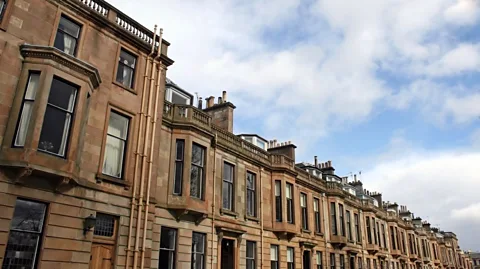 Getty Images
Getty ImagesIn post-war Glasgow, local authorities decided to tackle the city’s severe overcrowding. The 1945 Bruce Report proposed housing people in high-rises on the periphery of the city centre. The Clyde Valley Report published a year later suggested encouraging workers and their families to move to new towns. In the end, the council did a combination of both.
New towns like East Kilbride and Cumbernauld are now among the most populous towns in Scotland. Many of those who stayed in Glasgow were relocated to large housing estates like Drumchapel, Easterhouse and Castlemilk.
The rapid change in the city’s make-up was soon recognised as disastrous. Relocating workers and their families to new towns was described in mid-1960s parliamentary discussions as “skimming the cream”. In an internal review in 1971, the Scottish Office noted that the manner of population reduction was “destined within a decade or so to produce a seriously unbalanced population with a very high proportion [in central Glasgow] of the old, the very poor and the almost unemployable…”
Although the government was soon aware of the consequences, these were not necessarily intentional, says Walsh. “You have to understand what sort of shape Glasgow was in, in terms of the really lousy living conditions, the levels of overcrowded housing and all the rest of it,” he says. “They thought the best approach was to just start afresh.”
In the early 20th Century, cities were meant to show us how to live. Modern urban planning would make people in the world’s cities healthier and happier. In 1933, the influential Swiss-French architect and urban planner Charles-Edouard Jeanneret, better known as Le Corbusier, published his blueprint for the ideal city. In contrast with the past, he said, the city would now be designed to benefit its residents “on both the spiritual and material planes”.
In his plans for the Radiant City, industrial, commercial and residential zones would be segregated to allow workers to escape pollution; homes would be surrounded by open green spaces to allow residents to meet; wide roads would be set out in a grid system; and high-rise blocks would help clear the slums, remnants of the rapid industrialisation in many cities during the 19th Century. These slums were overcrowded and insanitary, and their inhabitants were, as the architect put it, “incapable of initiating ameliorations”.
Glasgow was among the first and the most enthusiastic to adopt these new buildings. In 1954 a delegation of councillors and planners visited Marseilles to see the Unité d’Habitation, an 18-storey block of flats and amenities resting on concrete stilts, designed by Le Corbusier and finished two years before. Glasgow soon had the highest number of high-rise dwellings in the UK outside London.
Sighthill’s ten 20-storey tower blocks were meant to herald the future. North of the city centre, set in parkland, with a view over the city, they would house more than 7,000 people drawn from the tenements and the slums.
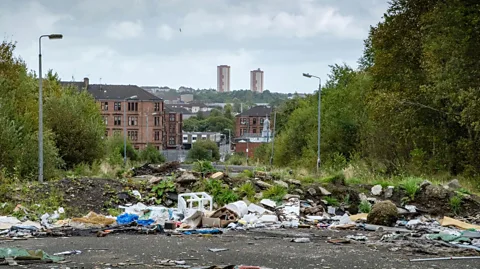 Chris Leslie for Mosaic
Chris Leslie for MosaicBut when the tenements went, something else went, too. “There were communities which had a social fabric, if you like, which were then broken up by these processes,” says Walsh.
By the 2000s, the tower blocks were infamous for deprivation, violence and drugs. Many residents had moved out. Empty flats were used to rehouse asylum seekers. Fractures within the community were worsening.
Glasgow Housing Association decided to condemn the buildings. The towers were demolished over eight years; the last one came down in 2016.
But the roots of Glasgow’s excess mortality stretch back further than new towns and high-rises – to the Industrial Revolution, argues Carol Craig, who has written two books on the subject. In Glasgow, then called the Second City of the Empire, factories and the docks needed workers. Overcrowding coupled with a culture of drinking produced an explosive situation.
Faced with the prospect of returning to a cramped tenement, many men preferred to visit the pub; there were few other public meeting places. “You’re more likely to have violence, you’re more likely to have conflict, even sexual abuse is much higher in households where there are drinkers,” Craig says.
Being exposed in childhood to stressful events like domestic violence, parental abandonment, abuse, or drug and alcohol addictions is thought to be linked to poor mental and physical wellbeing in later life. The higher a person’s number of Adverse Childhood Experiences, as they are called, the more likely they are to suffer from mental illness or addiction. In turn they are more likely to expose their children to similar types of experiences, says Craig. “ACEs tend to cascade through the generations.”
Since Le Corbusier, we have learned more about how the design of buildings can affect behaviour. In an oft-cited study from 1973, psychologists looked at how the design of two student dormitories at Stony Brook University in Long Island changed how the 34 residents in each interacted with each other.
In the first design, all the students shared common lounge and bathroom facilities along a corridor. In the second, smaller groups of four to six each shared bathrooms and lounges. They found that the first design was a “socially overloaded environment” which did not allow residents to regulate who they interacted with and when. Being faced with too many people, at times not of their choosing, led students to experience stress; they became less helpful and more antisocial than those in the second design as the year went on.
 Getty Images
Getty ImagesPerhaps the most famous case study of buildings’ effects on their inhabitants still referenced today is Pruitt–Igoe in St Louis, 33 11-storey towers inspired by Le Corbusier. Finished in 1956, it was initially seen as a miracle solution to inner-city living. Less than 20 years later, the social problems the blocks seemed to have spawned were deemed so irreparable that the buildings were imploded by the local authorities.
The architect Oscar Newman toured the complex in 1971, a year before demolition started. He argued that the design of a building affected the extent to which residents contributed to its upkeep. If people feel responsible for both keeping an area clean and controlling who uses it, it is likely to be safer. He called this sense of ownership over a territory “defensible space”.
“The larger the number of people who share a communal space, the more difficult it is for people to identify it as theirs or to feel they have a right to control or determine the activity taking place within it,” Newman wrote. Pruitt–Igoe was not designed to accommodate defensible space. “Landings shared by only two families were well maintained, whereas corridors shared by 20 families... were a disaster – they evoked no feelings of identity or control.”
Tower blocks with more wealthy residents are less likely to have issues with defensible space: they can pay for cleaners and security guards. Children, on the other hand, are often most affected: these common areas – communal corridors, or landings, or the nearby park – are usually spaces for play.
During his inauguration as rector of Glasgow University in 1972, the Clydeside trade unionist Jimmy Reid argued powerfully that working-class communities left behind by economic advancement were being stored out of sight. “When you think of some of the high flats around us, it can hardly be an accident that they are as near as one could get to an architectural representation of a filing cabinet.”
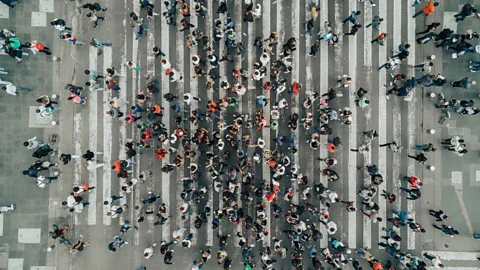 Getty Images
Getty ImagesInequality is at its most conspicuous in cities: the very poor and the very rich live side by side, yet separately. Relative social status is more likely to be the first measure by which we judge people in places where communities are more transient and inequality starker. This has been shown to have an impact on our psychological wellbeing.
In their book The Inner Level, epidemiologists Kate Pickett and Richard G Wilkinson argue that inequality not only creates social rupture by highlighting people’s differences but also encourages competition, contributing to increased social anxiety. They cite a 2004 paper by two psychologists at the University of California, Los Angeles – Sally Dickerson and Margaret Kemeny – who analysed 208 studies to find that tasks involving some threat of social evaluation affected stress hormones the most.
Pickett and Wilkinson argue that this type of stress harms our psychological health. “The more unequal countries had three times as much mental illness as the more equal ones.” This affects people of all social classes. In high-inequality countries, such as the USA and the UK, even the richest 10% of people suffer more anxiety than any group in low-inequality countries except the poorest 10%.
Research has also shown that living in a city can alter our brain’s architecture, making it more vulnerable to this type of social stress. In 2011, a team led by psychiatrist Andreas Meyer-Lindenberg of Heidelberg University’s Central Institute of Mental Health in Mannheim, Germany, looked at the implications of urban living on brain biology in one of the first experiments of its kind.
The scientists scanned the brains of 32 students while they were given arithmetic tasks and simultaneously subjected to criticism on headphones. This was designed to simulate social stress. A further 23 performed the same test but were subjected to a different kind of social evaluation: they could see the frowning faces of invigilators while completing the puzzles. The results of the test were stark: the participants who lived in a city demonstrated a greater neurophysiological reaction to the same stress-inducing situation. The amygdala, an area of the brain which processes emotion, was activated more strongly in current urban dwellers. The test also showed a difference between those who’d grown up in cities and those brought up in towns or the countryside. The former displayed a stronger response in their perigenual anterior cingulate cortex, which regulates the amygdala and is associated with stress and negative emotion.
Meyer-Lindenberg’s previous work on risk mechanisms in schizophrenia focused on genes. But these are only thought to account for a 20% increased chance of developing the illness at most – and growing up in a city is associated with double the risk.Stressful experiences in early life correlate with reduced volume of grey matter in the perigenual anterior cingulate cortex, a factor often seen in people with schizophrenia. “Mental health is almost uniformly worse in cities… that’s just what the data shows,” says Meyer-Lindenberg. “There isn’t really a bright side to this.”
Lack of agency – the feeling that we don’t have control over a situation – is one of the core mechanisms determining how strongly social stress is experienced, says Meyer-Lindenberg. “People who are in leadership positions tend to cope better with a given amount of stress.”
In a city, and particularly if you are poor, you are far more dependent on other people and the urban infrastructure, whether it’s waiting impatiently for a bus or a lift, wondering who you’ll have to share a lift with in your high-rise complex, or hoping the local council will not choose your neighbourhood for redevelopment.
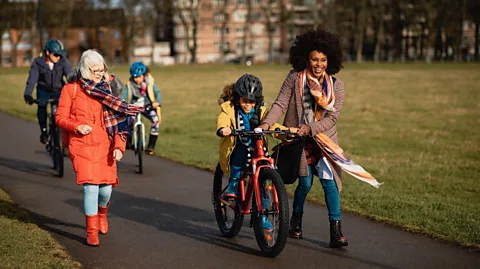 Getty Images
Getty ImagesCities can also be liberating. “The flip side of being more stressful is that they may be more stimulating,” Meyer-Lindenberg says. “This tighter community that you have in a village, say, can be very oppressive if you don’t feel like you belong, if you’re an outsider of some sort.”
Inequality has been shown to lower trust in others and damage social capital – the networks between people which allow societies to function effectively. People are so worried about security that they’re mentally building walls around themselves, says Liz Zeidler, chief executive of the Happy City Initiative, a research centre based in Bristol. “We need to be doing the opposite: we need to be creating more and more spaces where people can connect, learn across their differences.”
Happy City has designed a way to measure the local conditions shown to improve well-being. Its Thriving Places Index looks at housing, education, inequality, green space, safety and community cohesion.
Perhaps, however, a good measure for the happiness of a place, Zeidler says, is the status of the “indicative species”. For ponds, she says, it might be that the presence of a certain type of newt tells you whether or not the water is healthy. In cities, the newts are children. “If you can see children, it’s probably a healthy and happy city.”
The way a city is laid out can foster this environment, she says, by “closing of streets, making it more pedestrianised, more green spaces, having more what urban planners would call ‘bumping spaces’, where you can literally bump into people. Slowing places down is really good for everybody’s wellbeing and, obviously, you then see more children on the streets.”
If designed well, cities can be good for us. “If you look at urban dwellers epidemiologically they tend to be richer, better educated, [with] better access to healthcare,” says Meyer-Lindenberg. “And they also tend to be somatically healthier.” They also tend to have a smaller carbon footprint. “You can’t raze cities to the ground and rebuild them,” he says. “You have to find ways to maximise people’s wellbeing.”
Meyer-Lindenberg is currently tracking how different parts of the city affect our mental wellbeing, using a technique called ecological momentary assessment, in which participants repeatedly report on the environment around them in real time. Various studies have suggested that nature – be that a tree or a park – has an important impact on people’s mental health. The app he is currently designing will allow people to plan their routes through the city in order to maximise their exposure to nature.
“The most beneficial nature is the one that looks like the kind of nature that humans would have encountered during their early evolution,” he surmises. Perhaps the manicured parks of the type preferred by urban planners may not actually be that effective at improving our wellbeing.
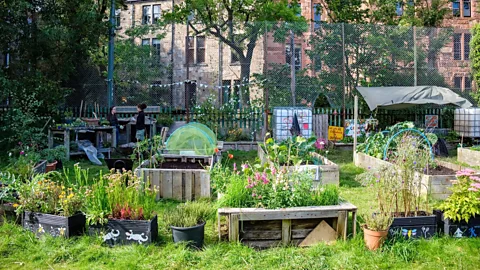 Chris Leslie for Mosaic
Chris Leslie for MosaicIn 2012, Emily Cutts realised the importance of these kinds of green spaces when the meadow overlooked by her second-floor flat in west Glasgow was threatened with development. Once used as an informal football pitch by locals, the meadow had mostly been frequented by dog walkers and drug addicts since the council, who wanted to sell the land, removed the goalposts. Then it finally looked as if a plan to build 90 luxury flats might pass.
Cutts decided that the only way to save the meadow was to launch a campaign. Over the next few years, the community organised petitions, events and a three-month vigil in St George’s Square in the city centre. Eventually the Scottish government stepped in. On 21 December 2016, it was determined that the meadow would remain undeveloped. It’s known locally as the Children’s Wood and is managed by a charity.
But why did Cutts and her fellow campaigners fight so passionately for this dingy meadow? Her neighbourhood, about ten minutes north of the Botanic Gardens, already had plenty of green space. Was it simply a case of not wanting development on her doorstep?
When I meet Cutts, in the community garden, she is deep in discussion with the gardener, Christine, about the possibility of using a wormery to transform dog faeces into compost for the trees. There are raised beds for planting, a bathtub with upturned earth for children to dig and an “edible” teepee (pea shoot tendrils will soon be climbing up the twigs). It was planted by a 12-year-old boy who, Cutts tells me, is regularly excluded from school.
Cutts is slight with long blonde hair, a soft Glaswegian accent and an eager countenance. She has an MSc in positive psychology. It was while working as Carol Craig’s researcher, compiling and presenting research on how to improve wellbeing, that she grew to understand the meadow’s potential to make her community healthier and happier.
Today, more than 20 schools and nurseries from the local area use the meadow. During my visit, Kelvinside Academy is having a forestry lesson. Children are playing around the thin birch trees, tying ropes around them, swinging friends vigorously in hammocks that look like laughing body bags, and digging in the earth. They learn to use knives for woodland tasks.
Cutts collaborated with a researcher at the University of Glasgow on a series of tests comparing the attention spans of children who spent their lunchtime in the meadow with those who stayed indoors or played in the school’s concrete playground. The attention of children exposed to nature was “significantly better”. Attention restorative theories argue that nature can have an impact on our attention span by engaging our indirect attention; this allows the type of attention we use for more challenging cognitive tasks, such as mathematical problems, to recuperate. The team also performed a similar experiment looking at children’s creativity in art. “Children who came here used more colours, used more texture, made more depth to their pictures than those who hadn’t played outside,” says Cutts.
 Chris Leslie for Mosaic
Chris Leslie for MosaicRichard Mitchell, a professor in the Social & Public Health Sciences Unit at the University of Glasgow, has also been looking at how exposure to nature affects stress in deprived communities. Despite previous research showing a beneficial impact, his own findings have shown it to be slight. “These are all very deprived communities with a whole range of other problems going on, and the detrimental impact of life in poverty and other stressful situations is not outweighed by access to green space,” he tells me over the phone. “I think what we have to understand is that at a population level it may not have an absolutely spectacular impact straight away, [but] it is important.”
Further study, however, showed that one aspect of exposure to nature “had pretty strong protective effects on mental health in adulthood”, Mitchell says. Those who had been part of youth groups like the Scouts or Guides, and had repeated contact with nature over a long period of time “where they’re learning a whole variety of skills including being outdoors and appreciation of nature”, were less vulnerable to mental ill-health.
The Children’s Wood charity runs a regular youth club where they bring young people to help with the gardening. Many of the children come from deprived families: “That’s what always interests us about the space,” says Cutts. “It’s bang right in the centre of inequality – there’s so much poverty and there’s a lot of affluence around. So, we feel it’s sort of a level playing field and everybody is welcome.” Unlike in parks, which can be anonymous, here you have “a committed community who are involved in the space,” she says.
We go up the road together to visit a GP at home who works in Possilpark, one of the poorest districts in the city. She prescribes visits to the Children’s Wood, in addition to other treatments, due to the benefits of “peer support, getting out of your house, talking to others, getting more engaged in your community, watching things grown, nurturing other things, nurturing oneself and self-care”. She says that when her patients talk about the wood, it is one of the few times she sees them smile.
Over 60% of Glasgow’s population lives within 500m (1,640ft) of a derelict site. A 2013 study found that vacant land and deprivation were linked to poor mental and physical health. It recommended that the city council grant the more than 700 hectares (2.7sq miles) available to highly deprived communities to be used for community good.
“Reclaiming the land for community is definitely the way forward,” Cutts says, as we both look over the meadow in the drizzling rain. “You can tell there’s a need but it’s not happening all over and it could be.”
In some parts of Glasgow, it feels like things could be changing, though it is mostly testament to the resilience of those who live there.
In the evening after my visit to the Children’s Wood, Cutts shows me the youth programme where 40 or so children are learning how to trampoline. As I wait for the bus, in the soft grey evening, I see some of the children leaving, mostly boys who are about 13 or 14, jostling and pushing each other playfully in the middle of the wide road. This is why we have to make our urban spaces happier and healthier. They are the newts in the city.
--
This is an edited version of an article that was first published by Wellcome on Mosaic and is republished here under a Creative Commons licence.
If you liked this story, sign up for the weekly bbc.com features newsletter, called “The Essential List”. A handpicked selection of stories from BBC Future, Culture, Worklife, and Travel, delivered to your inbox every Friday.

